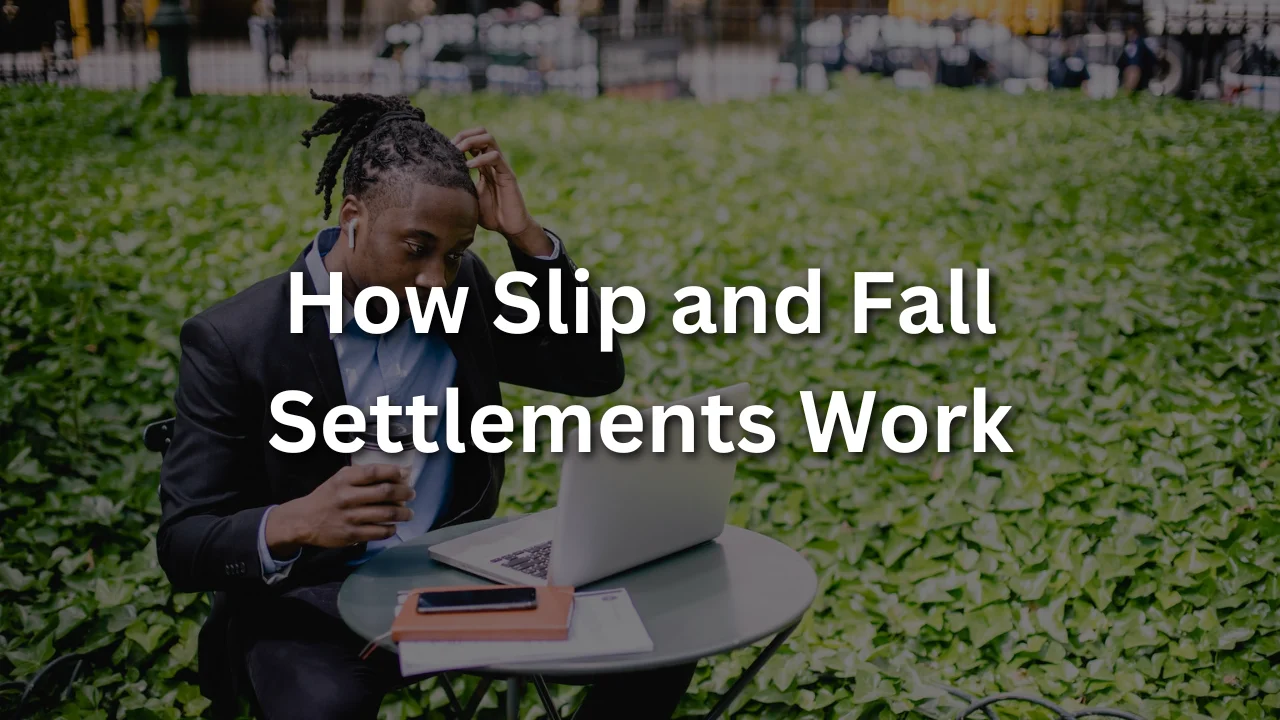In this article, you will discover the ins and outs of slip and fall settlements. Whether you’ve recently experienced a slip and fall accident or simply want to understand the process better, this article aims to provide you with a friendly and informative overview. From understanding the factors that contribute to a successful settlement to knowing what steps you can take to protect your rights, you’ll gain valuable insights into how slip and fall settlements work. So, grab a cup of tea, get comfortable, and let’s uncover the key aspects of this often misunderstood legal process.

Overview of Slip and Fall Settlements
Slip and fall settlements refer to the compensation that an injured individual receives following a slip and fall accident on someone else’s property. These settlements are a legal resolution between the victim and the responsible party, typically the property owner or manager. Slip and fall accidents can result in serious injuries, and settlements aim to provide financial support to the injured individual to cover medical expenses, rehabilitation costs, and other damages.
Definition of Slip and Fall Settlements
Slip and fall settlements are legally binding agreements where the responsible party agrees to provide compensation to the injured party to resolve the claim. These settlements can be reached through negotiations between the parties involved, often with the assistance of their respective attorneys. The settlement amount is typically based on various factors such as the severity of the injuries, impact on the victim’s life, medical expenses, and lost wages.
Importance of Slip and Fall Settlements
Slip and fall settlements are essential for ensuring that injured individuals receive the financial compensation they deserve. These settlements help cover medical bills, rehabilitation costs, lost wages, and other damages resulting from the accident. Without a settlement, victims would have to bear the burden of these expenses on their own, which can be incredibly challenging, both financially and emotionally. Additionally, slip and fall settlements provide a sense of closure and allow the injured party to move forward with their life.
Common Causes of Slip and Fall Accidents
Slip and fall accidents can occur due to various factors, and it is crucial to understand the common causes to prevent such incidents. Some common causes of slip and fall accidents include:
- Wet or slippery floors: Spills, rainwater, or recently mopped surfaces can create hazards for pedestrians.
- Uneven or damaged flooring: Cracked or uneven floors, loose tiles, or damaged carpets can increase the likelihood of tripping and falling.
- Insufficient lighting: Poorly lit areas can make it difficult to see potential hazards, leading to accidents.
- Inadequate signage: Absence of warning signs for wet floors or dangerous areas can contribute to slip and fall accidents.
- Obstacles and clutter: Objects or debris left in walkways can cause people to trip and fall.
By addressing these common causes, property owners and managers can help prevent slip and fall accidents and protect the safety of visitors.
Steps to Take After a Slip and Fall Incident
If you have been involved in a slip and fall incident, it is important to take certain steps to protect your rights and strengthen your potential slip and fall settlement claim. Here are the recommended steps to follow:
- Seek medical attention: Your health and well-being should be the top priority. It is essential to seek medical treatment promptly, even if the injuries seem minor initially. Documenting your injuries is crucial when pursuing a slip and fall settlement.
- Report the incident: Notify the property owner or manager about the accident as soon as possible. It is important to create a record of the incident, preferably in writing, to ensure there is documentation of the occurrence.
- Gather evidence: Take photographs of the accident scene, including any hazardous conditions that contributed to the slip and fall. Collect contact information from any witnesses present during the incident.
- Preserve footwear and clothing: Do not discard the shoes or clothing you were wearing at the time of the accident. They may serve as evidence in establishing the cause of the slip and fall.
- Consult with a personal injury attorney: Reach out to an experienced personal injury attorney specializing in slip and falls. They can guide you through the legal process, assess the strength of your case, and help negotiate a fair settlement on your behalf.
By following these steps, you can protect your rights and increase your chances of obtaining a favorable slip and fall settlement.
Determining Liability in Slip and Fall Cases
Determining liability in slip and fall cases is a crucial aspect of securing a favorable settlement. Establishing liability involves determining who is responsible for the accident and subsequent injuries. Here are key factors that contribute to determining liability:
Responsibility of Property Owners
Property owners or occupiers have a legal duty to maintain their premises in a reasonably safe condition. They are responsible for identifying and rectifying any potential hazards that could lead to slip and fall accidents. If they fail to fulfill this duty, they may be held liable for any injuries that occur on their property.
Negligence and Duty of Care
To prove liability, the injured party must demonstrate that the property owner or occupier was negligent. Negligence refers to the failure to exercise a reasonable level of care, leading to harm or injury. The property owner or occupier owes a duty of care to visitors, ensuring the premises are reasonably safe and free from hazards.
Comparative Fault and Contributory Negligence
Some slip and fall cases involve the injured party’s own negligence contributing to the accident. In such cases, the concept of comparative fault or contributory negligence comes into play. Comparative fault means that the injured party’s compensation may be reduced by the percentage of fault they hold in the accident. Contributory negligence, on the other hand, may completely bar the injured party from recovering any compensation if they are found to be at fault to a certain degree.
Proving Liability in Slip and Fall Cases
Proving liability in slip and fall cases involves gathering evidence to demonstrate that the property owner or occupier failed to uphold their duty of care. This can be achieved through various means, including:
- Documenting the hazardous condition that caused the accident through photographs or videos.
- Gathering witness statements that support the claim.
- Providing medical records and expert opinions to establish the connection between the injuries and the slip and fall incident.
By clearly demonstrating negligence on the part of the property owner or occupier, the injured party can strengthen their slip and fall settlement case.
Factors Affecting Slip and Fall Settlements
Several factors contribute to the amount of a slip and fall settlement. These factors take into account the specific circumstances of the case and the resulting damages. Here are some key factors that can affect the settlement outcome:
Severity of Injuries
The severity of the injuries sustained in a slip and fall accident is a significant determinant of the settlement amount. More severe injuries, such as broken bones, head trauma, or spinal cord injuries, often result in higher settlement values. This is due to the increased medical expenses, long-term treatment, and potential impact on the victim’s quality of life.
Impact on the Victim’s Life
A slip and fall accident can have lasting effects on an individual’s life. Settlement amounts often consider the impact the injuries have on the victim’s ability to work, engage in daily activities, and enjoy their life as they did before the accident. If the injuries significantly hinder the victim’s quality of life, the settlement amount may be higher.
Medical Expenses and Rehabilitation Costs
The medical expenses incurred as a result of the slip and fall accident play a vital role in determining the settlement amount. These expenses include hospital bills, surgeries, medication, physical therapy, and any ongoing treatment required for recovery. The higher the medical expenses, the higher the potential settlement value.
Lost Wages and Future Earning Capacity
If the injuries from the slip and fall accident prevent the victim from working, the settlement may account for lost wages during the recovery period. Additionally, if the injuries result in long-term or permanent disability, the settlement may include compensation for the victim’s diminished earning capacity.
By considering these factors, the injured party and their attorney can calculate a fair settlement amount that adequately compensates for the damages suffered.
Calculating Damages in Slip and Fall Settlements
Calculating damages in slip and fall settlements involves assessing the various losses and harms suffered by the injured party. Damages can be divided into the following categories:
Compensatory Damages
Compensatory damages aim to reimburse the injured party for the losses suffered. These damages can be economic or non-economic in nature. Economic damages cover tangible expenses such as medical bills, rehabilitation costs, lost wages, and property damage. Non-economic damages account for the intangible losses such as pain and suffering, emotional distress, and loss of consortium.
Pain and Suffering Damages
Pain and suffering damages compensate the injured party for the physical pain, mental anguish, and emotional distress experienced as a result of the slip and fall accident. Determining the exact value of pain and suffering damages can be challenging, as they are subjective in nature. Factors considered include the severity of the injuries, the duration of the pain, and the impact on the victim’s life.
Punitive Damages
In rare cases, punitive damages may be awarded in slip and fall settlements. Punitive damages are intended to punish the responsible party for their reckless or intentional actions that caused the accident. They aim to deter similar behavior in the future.
Factors Considered in Calculating Damages
Various factors are taken into account when calculating damages in slip and fall settlements. These factors can include the severity of the injuries, the level of negligence on the part of the responsible party, the victim’s age and occupation, and the financial resources of the defendant. Additionally, past settlement amounts for similar cases or jury verdicts can also influence the calculation.
By carefully assessing the damages and considering these factors, a fair and just settlement amount can be determined.
Negotiating Slip and Fall Settlements
Negotiating slip and fall settlements is a crucial step towards resolving the claim and obtaining a fair compensation amount. It is advisable to seek legal representation from a skilled personal injury attorney experienced in slip and fall cases. Here are the key aspects of the negotiation process:
Importance of Legal Representation
Having a personal injury attorney representing you during the settlement negotiations can significantly improve your chances of receiving a favorable outcome. An experienced attorney understands the complexities of slip and fall cases, knows the tactics used by insurance companies, and can effectively advocate for your rights and best interests.
Demand Letter and Initial Negotiations
After evaluating your case, your attorney will prepare a demand letter outlining your injuries, damages, and a proposed settlement amount. The demand letter is typically sent to the responsible party’s insurance company. Negotiations may begin as the insurance company responds with a counteroffer. Your attorney will work with you to navigate these negotiations, considering factors such as your desired settlement amount, the strength of your case, and any potential future costs.
Mediation and Settlement Conferences
If initial negotiations do not yield a satisfactory settlement, mediation or settlement conferences may be the next steps. These processes involve a neutral mediator or a judge facilitating discussions between the parties to explore potential agreements. Mediation and settlement conferences can provide an opportunity for compromise and reaching a mutually acceptable settlement without going to trial.
Accepting a Settlement Offer
Ultimately, the decision to accept a settlement offer rests with the injured party. It is important to carefully review the terms and consider the potential outcomes if the case were to proceed to trial. Your attorney will provide guidance and advice throughout the process, helping you make an informed decision that aligns with your best interests.
Challenges in Slip and Fall Settlements
Slip and fall settlements can face several challenges, which may impact the outcome of the case. It is crucial to be aware of these challenges when pursuing a settlement:
Disputes Over Liability
Determining liability in slip and fall cases can sometimes be contentious, with the responsible party denying their negligence. They may argue that the injured party was at fault, complicating the settlement negotiations. Resolving disputes over liability requires thorough investigation, strong evidence, and persuasive arguments to establish negligence.
Disputed Contributory Negligence
When the injured party’s own negligence contributes to the slip and fall accident, it can lead to disputes over contributory negligence. The responsible party may attempt to shift blame onto the injured party, arguing that their actions or lack of caution caused or worsened the injuries. Proving the extent of each party’s fault can be challenging and can impact the settlement amount.
Proving the Extent of Injuries
Insurance companies and opposing parties may challenge the severity of the injuries or dispute the connection between the injuries and the slip and fall incident. They might question medical reports or seek second opinions to diminish the value of the claim. Overcoming this challenge often involves presenting extensive medical records, expert opinions, and other evidence to establish the injuries’ impact.
Difficulties in Calculating Non-Economic Damages
Unlike economic damages, which have tangible monetary value, non-economic damages such as pain and suffering can be challenging to quantify. Different parties may have varying opinions on the appropriate value for these damages, leading to increased negotiation difficulties. Working with an experienced personal injury attorney can help navigate this challenge and ensure a fair assessment of non-economic damages.
Despite these potential challenges, with the right legal representation and diligent preparation, slip and fall settlements can still be achieved.
Benefits of Settling Slip and Fall Cases
Settling slip and fall cases provide several advantages for both the injured party and the responsible party. Here are some key benefits of settling:
Faster Resolution Compared to Litigation
Settling a slip and fall case avoids the lengthy litigation process, which can take months or even years to complete. Settlements allow for a more expedited resolution, offering quicker access to compensation for the injured party.
Avoidance of Court Costs and Attorney Fees
By settling the case, both parties can avoid the extensive costs associated with going to trial. Litigation expenses, such as court fees, expert witness fees, and attorney fees, can accumulate significantly throughout the process. Settling outside of court allows both parties to save on these costs.
Reduced Emotional Stress on the Victim
The legal process can be emotionally draining, especially for those who have suffered injuries and are dealing with the aftermath of a slip and fall accident. Settling the case allows the injured party to avoid the stress, uncertainty, and emotional toll associated with litigation.
Control Over the Outcome of the Case
Through settlement negotiations, both parties have the opportunity to actively participate in shaping the outcome of the case. By working together to reach a mutually satisfactory agreement, they can have more control over the resolution than if the case went to trial. This collaborative approach can lead to a more favorable outcome for both parties.
Steps of a Slip and Fall Settlement Process
The slip and fall settlement process involves several key steps to ensure a smooth and successful resolution. Here is an outline of the typical process:
Consulting with a Personal Injury Attorney
The first step in the settlement process is to consult with a personal injury attorney specializing in slip and falls. The attorney will evaluate your case, assess the available evidence, and provide guidance on the best course of action.
Investigating the Incident
Your attorney will conduct a thorough investigation into the slip and fall incident. This may involve gathering evidence, reviewing medical records, speaking with witnesses, and assessing the property’s maintenance history. The investigation aims to establish liability and build a robust case for settlement negotiations.
Gathering Evidence and Documentation
During the investigation, your attorney will help gather relevant evidence and documentation to support your claim. This may include photographs or videos of the accident scene, medical records, witness statements, and any other evidence that strengthens your case.
Filing a Claim and Initiating Negotiations
Once the evidence is gathered, your attorney will file a claim with the responsible party’s insurance company. The insurance company will review the claim and begin negotiations. Your attorney will skillfully negotiate on your behalf, working towards a fair settlement that adequately compensates you for your injuries and damages.
Key Considerations in Slip and Fall Settlements
Several key considerations need to be taken into account during slip and fall settlements. These considerations can significantly impact the outcome of the case and the settlement agreement. Here are some important factors to be aware of:
Statute of Limitations
Every state has a statute of limitations, which places a time limit on when a slip and fall claim must be filed. It is crucial to be aware of the specific time frame in your jurisdiction and promptly initiate legal proceedings before the deadline expires.
Insurance Coverage and Policies
Understanding the insurance coverage and policies of the responsible party is vital in slip and fall settlements. The insurance company may have limitations or exclusions that affect the amount and type of compensation available. Your attorney will carefully review these factors to ensure you are pursuing the maximum settlement possible.
Risks of Accepting a Settlement
While settlements offer many benefits, it is important to weigh the potential risks as well. Accepting a settlement means relinquishing your right to pursue further legal action against the responsible party. It is essential to thoroughly assess the settlement offer and consult with your attorney to ensure it aligns with your best interests.
Alternative Dispute Resolution Methods
If settlement negotiations prove challenging, alternative dispute resolution methods such as mediation or arbitration may be considered. These processes involve a neutral third party facilitating discussions between the parties to reach a mutually acceptable resolution. Exploring alternative dispute resolution methods can provide additional avenues for settlement and avoid the need for a lengthy court process.
Conclusion
Slip and fall settlements are a crucial aspect of obtaining compensation for injuries sustained in such accidents. Through careful consideration of liability, damages, negotiation techniques, and settlement processes, injured individuals can seek a fair and just resolution. A skilled personal injury attorney can provide invaluable guidance and ensure that the injured party’s rights are protected throughout the settlement process. By understanding the factors that impact slip and fall settlements, individuals can navigate the legal system confidently, seeking the compensation they deserve.












